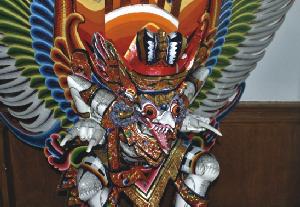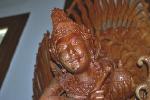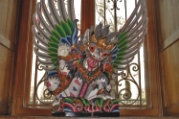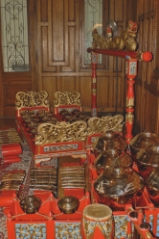An inter-war villa in the centre of town hides a treasure box of oriental secrets from the multitude of Indonesian cultures
 One factor that makes living in Bucharest easier for both ex-pats and some of its more architecturally sensitive residents is the charm of the city's fine inter-war buildings. On a side street, 10 Gina Patrichi Strada, between Piata Romana and Piata Victoriei, is a remarkable example of this period, which recalls the nation's flirtation with an aristocratic style and is now part of the Romanian patrimony.
One factor that makes living in Bucharest easier for both ex-pats and some of its more architecturally sensitive residents is the charm of the city's fine inter-war buildings. On a side street, 10 Gina Patrichi Strada, between Piata Romana and Piata Victoriei, is a remarkable example of this period, which recalls the nation's flirtation with an aristocratic style and is now part of the Romanian patrimony.
Under the utilitarian metal roof and behind the cool façade is a small and tasteful palace now host to the Embassy of Indonesia, where wood panels and Grecian-style bronze fittings mix with a collection of delightful objects and decorations from south-east Asia.
The three-storey building with 41 rooms is also known as the Lahovary Palace, named after its owners, an influential Romanian boyar family. The building was designed for the society figure Emanoil Lahovary by neo-romanticist Ion Mincu, founder of the New Romanian Style, which he did not rush to complete, taking him ten years to finish between 1920 and 1930. After the Second World War it was acquisitioned by the new regime and served as the headquarters of the Communist Party Committee.
 That was until 1983, when the Indonesian Embassy made the palace their home and now fill the classic rooms with ancient stories from religious Asian texts, the sounds of the gamelan and an administrative HQ for the world's most populous Islamic country.
That was until 1983, when the Indonesian Embassy made the palace their home and now fill the classic rooms with ancient stories from religious Asian texts, the sounds of the gamelan and an administrative HQ for the world's most populous Islamic country.
The gamelan, a set of traditional Javanese and Balinese musical instruments, is the first welcome visitors receive in the elegant and oak wood-coated entrance saloon. Around 15 people are needed to play the all-in-one orchestra: some play the xylophone-style plates or organ-like tubes, while others hit the drums, creating a gentle polyphony perfect for slow and aerial dance moves.
In the same saloon, beware of the two garudas, Indonesian painted wood griffins. Despite their grinning tiger-like jaws, bulging eye balls, spear-like fangs and hook claws, they are supposedly friendly, once you get to know them better. A triptych wooden panel with characters from the Mahabharata separates a reception area from the rest of the wide entrance room, surveyed by the garudas.
 Besides this spectacular saloon, at the ground floor there is also the Consular Office, the Administrative Office, the Information and Cultural Office and the office of the embassy's staff-related Women's Association.
Besides this spectacular saloon, at the ground floor there is also the Consular Office, the Administrative Office, the Information and Cultural Office and the office of the embassy's staff-related Women's Association.
On the same floor, a library is open to the public interested in Indonesia, offering books, magazines and newspapers in the official Indonesian language (one among the 150 to 200 different tongues in the country), English and Romanian, as well as a collection of video cassettes and CDs with Indonesian music.
Neighbouring the library, there is the Cultural Room, with a display of traditional costumes from the 17,000 islands of the archipelago. They are colourful and light-to-wear, sometimes decorated with spangles and beads and their Burgundy red, deep green or yellow folds seem to reflect the vivid and warm colours of the equatorial islands. Along the walls, other large musical instruments are in view: the angklung, made of bamboo tubes and similar to the wind organ and the kulintang, another xylophonesque item.
 A coquettish exhibition room completes the show on the ground floor with traditional Indonesian artifacts, cosmetics, agricultural and industrial products from Indonesia, food, scarves and rattan furniture. Timor, Sumatra, Java, Sulawesi or Papua are present with essential oils in little phials, sandal wood, jasmine, rose and patchouli lotions, papaya powders and beautiful purple, golden and green scarves.
A coquettish exhibition room completes the show on the ground floor with traditional Indonesian artifacts, cosmetics, agricultural and industrial products from Indonesia, food, scarves and rattan furniture. Timor, Sumatra, Java, Sulawesi or Papua are present with essential oils in little phials, sandal wood, jasmine, rose and patchouli lotions, papaya powders and beautiful purple, golden and green scarves.
Ascending the wooden stairs from the ground floor, one enters the main hall of the second floor where hang the portraits of the Indonesian president, Susilo Bambang Yudhoyono and vice-president, Muhammad Jusuf Kalla, near to a third garuda griffin, with a set of large fangs, ever-smiling.
The second floor shelters the wide and bright office of the Ambassador and the Political Section of the Embassy, while the third floor occupies the Economic Section. Out in the courtyard is a little villa where guests can stay for the short term, such as an Indonesian student coming to Romania for a study period.
Elegant in its use of Ion Mincu signature, while spiced up with the colours and scents of the Indonesian Archipelago, the Lahovary Palace is a mystical phantasmagoria in a classically formalist setting.